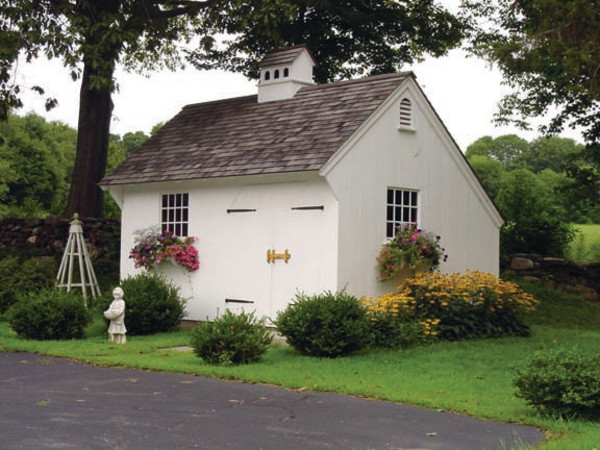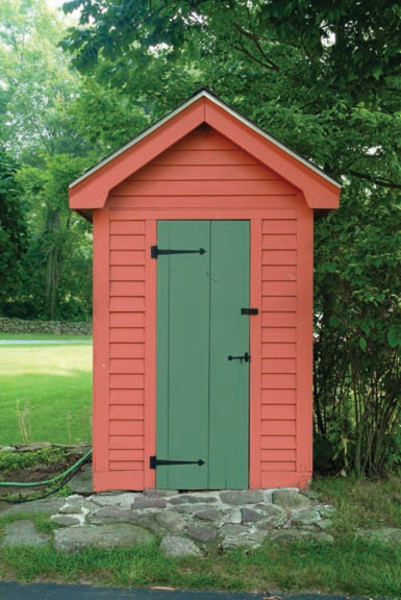Landscape architecture firm Horiuchi & Solien of Falmouth, Massachusetts, incorporated this shingled garden shed into a fenced vegetable garden. (Photo: Brian Vanden Brink)
A few weeks ago, I was at one of the big home stores, stocking up on some gardening supplies, and happened to notice the gardening sheds for sale. Various boxy prefab structures, by and large constructed of real wood but some made of composite or vinyl, were lined up along the edge of the parking lot like so many bits of flotsam on a beach. Expensive flotsam. When I went over to investigate, I was shocked to discover that the majority of these structures, 8′ by 10′ or so, were $1,500 or more.
Personally, I wouldn’t accept one of these structures on my property for payment, let alone purchase one, and I began to think about why my reaction was so viscerally negative. It wasn’t so much that they were ugly (they were—all built in mock country-barn style), but that they were also expensive. It seems to me that if you’re going to spend more than a thousand dollars on a structure for your garden, you should at least get something that doesn’t look like it was dropped randomly by some Oz-like tornado into the middle of your garden.
So what should you look for when choosing stylish sheds? First of all, style. Those of you who’ve read my column on a regular basis know that I continually advocate making sure every element in your garden is cohesively chosen to conform to the style of your house. If you have a New England Colonial, your shed should share that theme. If your house is a Frank Lloyd Wright–inspired ranch, your shed should be, too.
Country Carpenters designs garden sheds and outbuildings appropriate for traditional New England properties.
Of course, finding just the right design often isn’t easy, potentially even requiring custom construction, but frankly, care and attention spent now will save you a lot of headaches down the road. Customizable designs are readily available from online sources, which then can be handed off to a local carpenter to build. Or if you’re handy by nature, consider purchasing one of the many kits available from numerous suppliers across the country and building your own. These kits come in a far greater variety of styles than you’ll find for sale locally and are surprisingly easy to construct. The hardest part is forming and leveling the base; after that, it’s simply a giant Erector set. All the parts come precut; assembly requires only a power screwdriver. I built all the structures in my yard from such kits, with a minimal amount of fuss, each in about a day.
When buying a shed, be sure to choose one that’s as adaptable as possible. Remember, well-built sheds have long lives and may change function over time. In my garden, I have two outbuildings. Both structures started life as off-the-shelf kit sheds but were eventually converted to other purposes as my gardening needs and interests changed. As I became involved in raising heirloom chickens, for example, my slope-roofed shed ceased housing tools and, with the addition of some ventilation, became instead home to several dozen hens. The other, which I call the “bee house” because I store my apiary supplies there, was provided with a mini-deck after I realized it would make the perfect place to sit on a spring evening and enjoy the scent of apple blossoms. These alterations were possible only because both were built of quality materials from a good design. An earlier structure I purchased before I knew better, made of cheap pressed wood, rotted out and had to be demolished rather than reused.
Both of my outbuildings share another element that has greatly increased their usefulness and longevity: ample light. It may sound strange, but good lighting is crucial to the proper utilization of a garden shed. No matter what your intended purpose, if you can’t see what’s within, you can’t use it. And since most structures in the garden are far from an electricity source, ample natural light is key. My bee house possesses a sliding door with a glass window and two medium sidelights that can be opened as needed, flooding the interior with light and making it easy to find whatever I’m looking for. The coop actually has plastic panels built into its roof as a type of skylight that brilliantly illuminates the interior. Intended by the manufacturer as a gardener’s shed with potting bench where seedlings were meant to sprout, now heirloom hens contentedly bask in what has become a de facto avian solarium.
Historically inspired hardware can enhance the traditional look of your garden shed, as these iron strap hinges and thumb latch by Acorn Manufacturing demonstrate. (Photo: Eric Roth)
Concomitant with purpose goes size: You would be surprised how much room a mower, a few lawn chairs, and a small collection of tools can consume. Add a bit of workspace for the odd garden chore or project, and suddenly you’re talking about a considerable amount of space. Decide in advance what you plan to store in your shed, calculate the square footage, and then double it. I’m not sure why, but it’s a truism that sheds attract equipment like moths to a flame; the second you build one, it will be full. I’ve found from long experience that 8′ x 6′ is the smallest practical storage area for most home gardeners.
Finally, the old real estate adage of “Location, location, location!” really comes into play on the subject of stylish sheds. Storage facilities have to be strategically placed near where their contents will be used; otherwise, their utility is severely compromised. Think about where the maximum amount of gardening takes place on your property, and locate your shed logically in this area—as a focal point at the end of a vista, for instance, or centered along the side of your vegetable garden space.
This prominent location is another reason why your shed needs to look good: It’s now become a centerpiece of the garden. This often means additional construction in the form of pathways to provide access, fencing to frame or enclose the space, and planting to settle the structure into the garden, proving yet again that building a shed is not something to be undertaken lightly. But believe me, the first time you’re surprised by a spring shower and take refuge in your shed, surrounded by neat rows of implements snuggled safe and dry from the drops pitter-pattering on your new little roof, you’ll relax, look out over your tended plot, and breathe deeply of the sweet smell of gardening success. After all, a good shed is like a good friend: It’s always there when you need it.
Michael Weishan is the author of The New Traditional Garden. For more tips and techniques of traditional gardening, follow Michael’s Old House, Old Garden blog.







